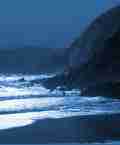 |
Search the site:

KERRY & West Corkit was odd how, standing in mist among ecclesiastical-looking cairns [on Brandon] , we looked down and saw that Smerwick and Ballyferriter were enjoying a day of sunshine, Brandon Head was rainy, and Mount Eagle was in cloud. Climbing west of Dingle is deceptive, a succession of false summits, each windier than the last; but from the heights of Brandon the whole peninsula is spread out like a topographical map, path and road, cove and headland.The Iveragh Peninsula has the highest mountains in Ireland; while not everyone would say that they are the most scenic mountains, few would dispute their attractions for the hill walker. Their layout is quite complex and the four sub-ranges detailed here are more for descriptive purposes than for geographic exactitude. The general trend is north-east to south-west following the lines of the drowned valleys which bound the peninsula. The Macgillycuddy's Reeks (usually called simply the "Reeks") lie directly west of Killarney. Westward is the horseshoe of hills at Glenbeigh, including the Knocknadobar range. South of the Reeks and stretching to the south-west corner of the peninsula run the Dunkerrons (name probably not authentic) and paralleling it, but farther east, the Mangerton range. To look at these ranges in more detail, let's start again at the Reeks. At the eastern end, the heather-covered Purple Mountain group (route 109) may be considered part of the Reeks but is a trifle mundane. West of the great slash of the Gap of Dunloe (route 127) are the Reeks proper: a long line of hills (the latest Ordnance Survey maps count six tops over 914 metres/3,000 feet) which fall away spectacularly in great cliffs to the north (routes 110, 126). At the western end is the semi-circle of hills around the corrie of Coomloughra which contains the three highest peaks in Ireland: Caher (1,001 metres/3,200 feet), Carrauntoohil (1,039 metres/3,4l4 feet) and Beenkeragh (1,010 metres/3,314 feet), the latter two connected by a striking knife-edge, the Beenkeragh ridge (route Ill). It hardly needs mentioning that a circuit encompassing these three peaks gives a memorable and exciting day. Glenbeigh (route 112) consists of rather dull moorland broken on its north-east side by a set of magnificent lake-filled corries separated by narrow spurs. The small Knocknadobar range directly to its west has good views of its own and neigh-bouring peninsulas, but it otherwise comparatively mundane. The Dunkerrons run from Broaghnabinnia (745 metres/ 2,440 feet) south-west along the spine of the peninsula for about forty kilometresltwenty-five miles. Mullaghanattin (773 metres/2,539 feet) (route 113) is the highest peak, and a circuit from north or south makes a magnificent walk. From the north, walkers will take in the complex tangle of bare and convoluted hills around Cloon Lough. South-westwards from Mullaghan-attin the spine continues over Knocknagantee (676 metres/ 2,220 feet) and Coomcallee to dwindle into lower hills to its west and south-west (routes 114, 128). This whole area south-west of Mullaghanattin is a remote and rugged one, much of it offering fine views of the sea and off-shore islands. In places, progress is greatly impeded by sandstone slabs similar to those described below under Beara. Walking in the area roughly south and west of Knocknagantee is hampered by poor mapping. The next 'Kerry' extract can be found here : Part 3
|
[ Back to Top ]
All Material © 1999-2009 Irelandseye.com and contributors
